Rebecca Eanes's Blog, page 26
November 16, 2013
Radical Approach to Stop Bullying
Yesterday a video was posted on Facebook that a local 6th grade student secretly filmed of his teacher shaming and berating the class. She called them a "waste of space" and told them they were "pathetic." She then said, "Most of you need to just stay home and be homeschooled and let your parents fool with you!"
The parent who posted it highlighted the fact that we teach our children not to bully but then they get bullied by the teachers we entrust them to. I'm willing to bet this is a much bigger problem than parents realize, and I'm hoping this begins to shed some light on the disrespect that children are forced to put up with every day.
But it isn't just teachers. Parents, caregivers, coaches, and relatives bully children constantly in the name of discipline or motivation. If we don't like their behavior, we hit them or take away their most loved possessions because we can. Because we've been told that's how we teach them to be good people, by making them miserable. Then we hope the effect is that they will be compliant so we don't make them miserable again. We are constantly holding our power and authority over their heads.
My friend, Genevieve Simperingham, shared this profound truth on her page The Way of the Peaceful Parent:
"Parents are urged to punish children who “misbehave” so that the children will feel bad and guilty. Guilt is considered to be the great motivating force behind socially acceptable behaviour. The children then learn to give up their nasty, uncivilized ways because they love their parents, want to please them, and want to be loved by them.
This belief has done more harm than any other belief invented by humanity. It is one of the main reasons the world is in such a mess. It has provided justification for violence, coercion, withdrawal of love, isolation, threats, and humiliation under the guise of “discipline”. It has caused entire populations to be blindly obedient to authority figures and unable to think clearly about how to act. It has produced generations of adults who are burdened with feelings of guilt, fear and shame. It has caused children’s real needs to go unmet, producing adults who go through life trying desperately and unsuccessfully to fill their early needs, looking for someone who can love, accept, and understand them.
If we could rid ourselves of this deeply entrenched notion, if we could treat a baby from the start with an open, accepting attitude, we would be able to catch a glimpse of the real human being with a vast potential for goodness. We would see an innate tendency for physical, mental, and emotional growth, a striving to understand the world, an astounding ability to give and receive love, cooperate with other human beings, learn new skills, and acquire knowledge. We would see the capacity to reach all the higher levels of human potential.
If we were able to fill all of this baby’s needs for love, understanding, stimulation, closeness, and nourishment, and if we treated her with the utmost respect and trust, we would see her grow, not into a destructive, selfish monster, but rather into a thoughtful, intelligent, cooperative, and loving adult.
When adults have tendencies towards destructiveness or violence we must assume that they were mistreated as children. People do not act in bad, stup, or hurtful ways unless they have experienced hurtful behaviour from others, or unless their needs as children were not met. Studies of criminals have repeatedly revealed severe and early mistreatments of these individuals in an environment that lacked understanding of their feelings and needs.” Aletha Solter p.118 in "Helping Young Children Flourish"
The fact of the matter is that until we stop bullying children, children aren't going to stop bullying each other. It's a vicious cycle.
Another poignant article on this topic came from The Organic Sister. Here's a snippet of what she wrote:
"Want to know why children are becoming bullies?
Because they are being bullied. Because they are listening to someone bigger than them say things like “little assholes” and “they deserve a beating”…they are listening to someone tell them what to do and criticize them and hurt them, and they learn that’s how it works: the bigger person has the power and the right to exert that power.
Want to know why kids don’t give a rip about others?
Because they have no examples of genuine engagement and kindness in their world. It’s demanded of them before it’s shown what it even looks like. (How in the world can they give respect when they’ve never seen what that even looks like to give? They’ve only seen what it looks like to demand submission, the antithesis of respect.)
So they turn to the smaller person – maybe it’s an older woman on a bus or a gay teen or the “nerd” in class – and they exert that same power and force over them."
It's time for adults to step up to the plate here. It's time to leave the gauntlet lay and try a new approach; one where we are not holding power over children but instead are working with them, teaching them, guiding them, and most importantly setting good examples for them to follow. Radical, I know.
It's easier to just hold our authority over their heads, isn't it? It's easier to say "do as I say, not as I do."
That's a cop out. Plain and simple.
I've read countless comments from parents who say they expect their children to be better and do better than them. WHY? Why should a CHILD who has been in this world for so short a time be expected to control their emotions and behaviors better than fully matured ADULTS? We have to put the work into BEING what we want them to be, and that means a lot of hard self work sometimes. We have to learn to discipline ourselves, to watch our tongues, to control our anger, and that's a lot harder than barking commands, but it's also a lot more effective, because children don't listen to what we say, they watch who we are. They imitate us. Let's give them compassion to imitate, kindness to imitate, gentleness to imitate, acceptance to imitate. We need to stop being their judges, juries, and punishers and start being their leaders, role models, encouragers, and supporters. We have to stop being big ole bullies.
Only then will see the bullying problem erased and a better society emerge.
The parent who posted it highlighted the fact that we teach our children not to bully but then they get bullied by the teachers we entrust them to. I'm willing to bet this is a much bigger problem than parents realize, and I'm hoping this begins to shed some light on the disrespect that children are forced to put up with every day.
But it isn't just teachers. Parents, caregivers, coaches, and relatives bully children constantly in the name of discipline or motivation. If we don't like their behavior, we hit them or take away their most loved possessions because we can. Because we've been told that's how we teach them to be good people, by making them miserable. Then we hope the effect is that they will be compliant so we don't make them miserable again. We are constantly holding our power and authority over their heads.
My friend, Genevieve Simperingham, shared this profound truth on her page The Way of the Peaceful Parent:
"Parents are urged to punish children who “misbehave” so that the children will feel bad and guilty. Guilt is considered to be the great motivating force behind socially acceptable behaviour. The children then learn to give up their nasty, uncivilized ways because they love their parents, want to please them, and want to be loved by them.
This belief has done more harm than any other belief invented by humanity. It is one of the main reasons the world is in such a mess. It has provided justification for violence, coercion, withdrawal of love, isolation, threats, and humiliation under the guise of “discipline”. It has caused entire populations to be blindly obedient to authority figures and unable to think clearly about how to act. It has produced generations of adults who are burdened with feelings of guilt, fear and shame. It has caused children’s real needs to go unmet, producing adults who go through life trying desperately and unsuccessfully to fill their early needs, looking for someone who can love, accept, and understand them.
If we could rid ourselves of this deeply entrenched notion, if we could treat a baby from the start with an open, accepting attitude, we would be able to catch a glimpse of the real human being with a vast potential for goodness. We would see an innate tendency for physical, mental, and emotional growth, a striving to understand the world, an astounding ability to give and receive love, cooperate with other human beings, learn new skills, and acquire knowledge. We would see the capacity to reach all the higher levels of human potential.
If we were able to fill all of this baby’s needs for love, understanding, stimulation, closeness, and nourishment, and if we treated her with the utmost respect and trust, we would see her grow, not into a destructive, selfish monster, but rather into a thoughtful, intelligent, cooperative, and loving adult.
When adults have tendencies towards destructiveness or violence we must assume that they were mistreated as children. People do not act in bad, stup, or hurtful ways unless they have experienced hurtful behaviour from others, or unless their needs as children were not met. Studies of criminals have repeatedly revealed severe and early mistreatments of these individuals in an environment that lacked understanding of their feelings and needs.” Aletha Solter p.118 in "Helping Young Children Flourish"
The fact of the matter is that until we stop bullying children, children aren't going to stop bullying each other. It's a vicious cycle.
Another poignant article on this topic came from The Organic Sister. Here's a snippet of what she wrote:
"Want to know why children are becoming bullies?
Because they are being bullied. Because they are listening to someone bigger than them say things like “little assholes” and “they deserve a beating”…they are listening to someone tell them what to do and criticize them and hurt them, and they learn that’s how it works: the bigger person has the power and the right to exert that power.
Want to know why kids don’t give a rip about others?
Because they have no examples of genuine engagement and kindness in their world. It’s demanded of them before it’s shown what it even looks like. (How in the world can they give respect when they’ve never seen what that even looks like to give? They’ve only seen what it looks like to demand submission, the antithesis of respect.)
So they turn to the smaller person – maybe it’s an older woman on a bus or a gay teen or the “nerd” in class – and they exert that same power and force over them."
It's time for adults to step up to the plate here. It's time to leave the gauntlet lay and try a new approach; one where we are not holding power over children but instead are working with them, teaching them, guiding them, and most importantly setting good examples for them to follow. Radical, I know.
It's easier to just hold our authority over their heads, isn't it? It's easier to say "do as I say, not as I do."
That's a cop out. Plain and simple.
I've read countless comments from parents who say they expect their children to be better and do better than them. WHY? Why should a CHILD who has been in this world for so short a time be expected to control their emotions and behaviors better than fully matured ADULTS? We have to put the work into BEING what we want them to be, and that means a lot of hard self work sometimes. We have to learn to discipline ourselves, to watch our tongues, to control our anger, and that's a lot harder than barking commands, but it's also a lot more effective, because children don't listen to what we say, they watch who we are. They imitate us. Let's give them compassion to imitate, kindness to imitate, gentleness to imitate, acceptance to imitate. We need to stop being their judges, juries, and punishers and start being their leaders, role models, encouragers, and supporters. We have to stop being big ole bullies.
Only then will see the bullying problem erased and a better society emerge.
Published on November 16, 2013 17:09
October 2, 2013
Arts vs. Crafts - Guest Post by MaryAnn Kohl
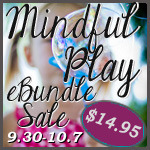 Welcome to the Mindful Play eBundle Sale from my affiliate partner. Grab your chance today to get 10 play-oriented e-resources geared toward kids ages 1 to 12. This bundle is only for sale until October 3, and the contributions will never again be sold together at this price. Only $14.95 for $79 of ebooks to inspire your family's creativity and play! BUY NOW!
Welcome to the Mindful Play eBundle Sale from my affiliate partner. Grab your chance today to get 10 play-oriented e-resources geared toward kids ages 1 to 12. This bundle is only for sale until October 3, and the contributions will never again be sold together at this price. Only $14.95 for $79 of ebooks to inspire your family's creativity and play! BUY NOW!***
Arts vs. Crafts
by MaryAnn F. Kohl
The terms art and crafts are often used interchangeably to describe the same activities for children, but they actually have important differences and learning implications. We are not talking about traditional crafts like candle making or basket weaving; we are talking about what most adults call "crafts" - that is, anything a child makes or creates: craft time at the library, crafts at camp, crafts class in school, crafts at church or synagogue, or the craft corner at daycare. Crafts have their place in a child's educational life, but it is art that is the truly important creative activity for children. How do we know the difference?
Art and Crafts: What's the difference?
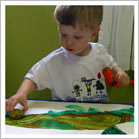 Because art and crafts are so different, it's good to know what makes them special and call them by their proper names. When children create art, they are exploring, discovering, and thinking. Art encourages a child's originality and unique expression with an unknown outcome. Crafts, on the other hand, involve the child's reproducing an adult's idea, while following directions to make a specific "thing" - a known outcome. Making crafts is about imitating what an adult has made and, as such, it requires no original thinking. Crafts are meant to be useful or practical, or to reinforce a fact or learning theme. Craft activities have value in this way, but art is a unique form of creativity that inspires each individual child to be original and inventive and to think for himself.
Because art and crafts are so different, it's good to know what makes them special and call them by their proper names. When children create art, they are exploring, discovering, and thinking. Art encourages a child's originality and unique expression with an unknown outcome. Crafts, on the other hand, involve the child's reproducing an adult's idea, while following directions to make a specific "thing" - a known outcome. Making crafts is about imitating what an adult has made and, as such, it requires no original thinking. Crafts are meant to be useful or practical, or to reinforce a fact or learning theme. Craft activities have value in this way, but art is a unique form of creativity that inspires each individual child to be original and inventive and to think for himself.Comparison Chart: Art vs. Crafts
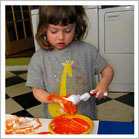 Value both art and crafts experiences for exactly what they are. Be clear when doing activities with kids and use the words "crafts" and "art" correctly. The chart below is useful for explaining differences:
Value both art and crafts experiences for exactly what they are. Be clear when doing activities with kids and use the words "crafts" and "art" correctly. The chart below is useful for explaining differences:Art Crafts creative, unique, original similar (or identical) to other children's comes from within the child directed from the adult open-ended, end results unknown closed, directions-oriented, end results known process is valued over finished product finished product is valued over process self-expression copying and imitating
Why Art? Process, Not Product
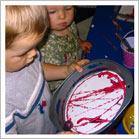 Adults often prefer to give kids cute crafts projects because the nearly cookie-cutter perfect results reflect well on the adult. (If the child's work looks good, then doesn't this mean the adult is doing a good job teaching?) The truth is actually the opposite: If a child is exploring and discovering while creating art, the child is learning far more than if he were merely copying an adult's idea of a finished product. Creating through open-ended art places the value on the process rather than the final product. The process involves discovering, exploration, and learning to trust one's own choices. The product is only the outcome of the exploration and discovery, a reflection of deeper learning. Children's art should be about process more than product, about feeling free to create, and about visually sharing a child's own thoughts and feelings. As children create art, there will be repetition and remaking and tweaking and manipulating materials to various outcomes and experiences, all unique to that child. Art pleases the child and honors unique individuality and diversity.
Adults often prefer to give kids cute crafts projects because the nearly cookie-cutter perfect results reflect well on the adult. (If the child's work looks good, then doesn't this mean the adult is doing a good job teaching?) The truth is actually the opposite: If a child is exploring and discovering while creating art, the child is learning far more than if he were merely copying an adult's idea of a finished product. Creating through open-ended art places the value on the process rather than the final product. The process involves discovering, exploration, and learning to trust one's own choices. The product is only the outcome of the exploration and discovery, a reflection of deeper learning. Children's art should be about process more than product, about feeling free to create, and about visually sharing a child's own thoughts and feelings. As children create art, there will be repetition and remaking and tweaking and manipulating materials to various outcomes and experiences, all unique to that child. Art pleases the child and honors unique individuality and diversity.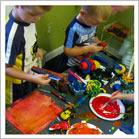 Art is creative and free, with only some very basic techniques to guide the experience; the process is heavily valued, and the finished product is not the main goal: It is the creative process that holds the most value. For young children, the exploration and discovery is foremost, and the finished product may not even exist! Sometimes children will value the finished artwork as a by-product to their creative explorations, and sometimes it is a way of telling what they experienced. Other times they set it aside and start something new — because it was the doing that mattered, not the outcome.
Art is creative and free, with only some very basic techniques to guide the experience; the process is heavily valued, and the finished product is not the main goal: It is the creative process that holds the most value. For young children, the exploration and discovery is foremost, and the finished product may not even exist! Sometimes children will value the finished artwork as a by-product to their creative explorations, and sometimes it is a way of telling what they experienced. Other times they set it aside and start something new — because it was the doing that mattered, not the outcome.Art: Learning Skills
Children learn through creating art. Art impacts a child's learning and development in the following areas:
Thinking and reasoning skills Problem-solving Trial and error Planning, organizing Estimating and measurement Matching, patterning, sequencing Spatial relationships Language skills Communication Symbolic representation of ideas Vocabulary Memory Physical skills Hand-eye coordination Fine motor and large motor skills Emotional skills Self-expression Purposefulness Self-worth Aren't Crafts Important, Too?
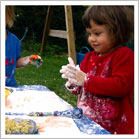 Crafts often have practical uses or are meant to reinforce a specific topic or learning theme in the classroom like safety, pets, or transportation. Crafts may go along with Math, Science, or other academic areas. When making crafts, children are often forming useful items or following directions to make projects or things that other kids are making too — even if they don't look exactly identical when complete. There will be uniformity to the work and an expected outcome for all participants. Crafts are designed to please adults as much as to offer children specific facts to learn or to reinforce the exercise of following directions. It's not that crafts are bad; it's just that crafts are not art. Use the word "art" when children create art, and "crafts" when they do crafts. This way, everyone understands the difference and learns to respect each activity for what it truly is. Crafts are fun and cute and a supplement to a child's learning and doing, but art should be the larger portion of a child's creative time.
Crafts often have practical uses or are meant to reinforce a specific topic or learning theme in the classroom like safety, pets, or transportation. Crafts may go along with Math, Science, or other academic areas. When making crafts, children are often forming useful items or following directions to make projects or things that other kids are making too — even if they don't look exactly identical when complete. There will be uniformity to the work and an expected outcome for all participants. Crafts are designed to please adults as much as to offer children specific facts to learn or to reinforce the exercise of following directions. It's not that crafts are bad; it's just that crafts are not art. Use the word "art" when children create art, and "crafts" when they do crafts. This way, everyone understands the difference and learns to respect each activity for what it truly is. Crafts are fun and cute and a supplement to a child's learning and doing, but art should be the larger portion of a child's creative time.Examples of Art and Crafts
To further illustrate art and crafts, here are two examples based on the use of the same main material - cotton balls:
Art Example: Cotton Ball Gluing
Provide cotton balls, glue, and collage materials like buttons, cardboard, and other materials on hand. Each child combines his unique choice of materials and glues them on a chosen background — for example, cardboard, paper plate, or construction paper. The child might conceivably make a bunny, but more likely, the child will create a collage (or something no one thought of before) that is his own process-rendered experience. The expectation is to create, using cotton balls and glue, with no planned outcome or product.
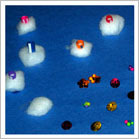
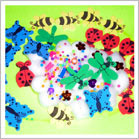
Craft Example: Cotton Ball Bunny
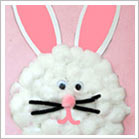 Glue cotton balls on a pre-cut cardboard bunny shape, filling the space. Next add pink construction paper ears. Glue on two buttons for eyes. The craft product is a fuzzy cotton ball bunny. Though no two will look exactly alike, all the bunnies use the same basic directions and materials with a uniform expectation, which is: Make a bunny on a pre-determined shape with cotton balls and glue. The outcome is cute. The process is pre-determined.
Glue cotton balls on a pre-cut cardboard bunny shape, filling the space. Next add pink construction paper ears. Glue on two buttons for eyes. The craft product is a fuzzy cotton ball bunny. Though no two will look exactly alike, all the bunnies use the same basic directions and materials with a uniform expectation, which is: Make a bunny on a pre-determined shape with cotton balls and glue. The outcome is cute. The process is pre-determined.Basic Supplies
For kids to explore art as a process, they need basic materials to work with. Whatever you have on hand will do, but if you're looking for some great basic supplies, here are suggestions of products found at BN.com:
Paint: Deluxe Poster Paint Set by Melissa & Doug Crayons: Triangular Grip Crayons by Creativity for Kids Markers: Washable Broadline Markers by Creativity for Kids Colored Pencils: Color Grip Color Pencils by Creativity for Kids Oil Pastels: Boat Ride Oil Pastels by eeBoo Marking Tools Set: Playful Art Set (12 ea. Markers, Crayons, Pencils) by P'kolino Scissors: Children's Safety Scissors by Creativity for Kids Clay: Model Magic Primary Colors by Crayola Paper: Doodling Pad by Creativity for Kids
Recommended books to inspire art with children found at BN.com:
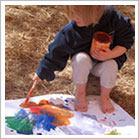
Scribble Art Preschool Art Primary Art Big Messy Art
Conclusion
It's a great feeling to relax and trust that your child is learning from art. Feel good that you allow the children you care about to create from their own explorations and ideas. Remember that, more than anything, it is the creative process that is most important for a child's learning through art. The final product is the delightful by-product of these precious early experiences with creativity — like a road-map of the learning that just took place.
 About the Author: MaryAnn Faubion Kohl, award-winning author, publisher, and educational consultant, has devoted her professional life to children's art and creativity. Her philosophy, "It's the process, not the product," guides her writing as she provides open-ended art activities for children of all ages. MaryAnn's books focus on the child's exploration and experience of art, not the final product. You can find out more on MaryAnn F. Kohl's website.
About the Author: MaryAnn Faubion Kohl, award-winning author, publisher, and educational consultant, has devoted her professional life to children's art and creativity. Her philosophy, "It's the process, not the product," guides her writing as she provides open-ended art activities for children of all ages. MaryAnn's books focus on the child's exploration and experience of art, not the final product. You can find out more on MaryAnn F. Kohl's website.Photos courtesy of Jean Van’t Hul, The Artful Parent
© copyright 2013 Jean Van’t Hul All Rights Reserved
Published on October 02, 2013 06:00
September 30, 2013
The Mindful Play eBundle Details!
I'd like to give you a peek into the amazing new e-bundle up at my affiliate partner: the Mindful Play eBundle.
This bundle contains 9 play-oriented e-resources, plus 3 phenomenal bonuses.
This ebundle is for sale only from September 30 through October 3. After that, you'll never see this particular collection together again at this price.
There's a little something for everyone, geared to kids from ages 1 to 12: coloring pages, a yoga story book, mandala drawing initiation, treasure baskets and sensory bins, modeling play, and much more.
Here's a bit more about the exciting contents:
 Sensory Bins: the What, the How and the Why
, by Sharla Kostelyk of The Chaos and the Clutter:
Sensory Bins: the What, the How and the Why
, by Sharla Kostelyk of The Chaos and the Clutter:Sensory bins are a simple and inexpensive learning tool that can benefit all children. Whether you are interested in incorporating sensory bins into your home, classroom, or homeschool, this guide will provide you the necessary knowledge and ideas to get started. It includes idea lists, storage and money saving tips, information on using sensory bins with Sensory Processing Disorder, and helpful recipes.
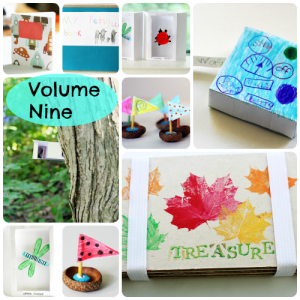 Alphabet Glue
, by Annie of Bird and Little Bird:
Alphabet Glue
, by Annie of Bird and Little Bird:Alphabet Glue is a downloadable e-magazine for families who love books. Filled with activities, printables, projects, and plenty of inspiration, Alphabet Glue was created in hopes of helping more families incorporate creativity, imagination and all things literary into their everyday routines. Each issue contains leveled book recommendations organized by theme, bookmaking tutorials, story-building activities, and hands-on projects that complement favorite titles in children's literature. From stories to science experiments, Alphabet Glue has a little something for everyone. This bundle includes two fall-themed issues: Volume 9 and Volume 14 —Â Fold functional paper periscopes for amateur espionage and make simple plant presses. Sail a fleet of tiny sailboats and learn a bit about surface tension in the process. Reflect on the shape of rain drops, and create a bit of refrigerator-ready art while you're at it. Make bouncy balls out of laundry room staples and handy office supplies, and spend a bit of time thinking about how fossils are formed before trying your hand at making your own. All this and more in two fun- and story-filled volumes!
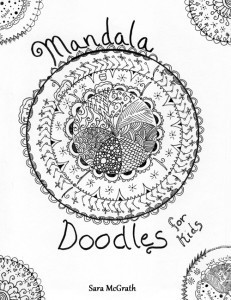 Mandala Doodles
, by Sara McGrath of Unschooling Lifestyle:
Mandala Doodles
, by Sara McGrath of Unschooling Lifestyle:Learn to draw mandala doodles. With something round to trace, pens, and an eye for discovering the patterns around you, you can draw round mandala doodles and non-circular doodle designs.
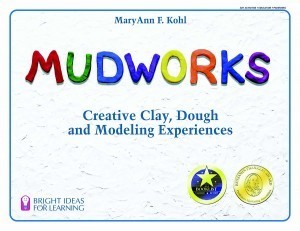 Mudworks: Creative Clay, Dough and Modeling Experiences for Kids
, by MaryAnn Kohl:
Mudworks: Creative Clay, Dough and Modeling Experiences for Kids
, by MaryAnn Kohl:Mudworks offers a delightful range of over 100 hands-on creative modeling mixtures and recipes for children to explore and experience. Kids like to call it the goosh and moosh book! All projects use common household materials and require no expertise. Ideal for fun or serious art for all ages, at home, school, or childcare. A classic!
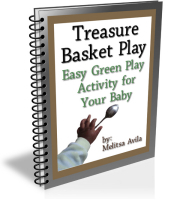 Treasure Basket Play
, by Melitsa Avila of Raising Playful Tots:
Treasure Basket Play
, by Melitsa Avila of Raising Playful Tots:Treasure Basket Play shows you step by step how to effectively and safely set up and use a treasure basket in your home today that will engage and challenge your baby each time the basket is used. Treasure basket play is suitable for sitting babies to approximately 12 months.
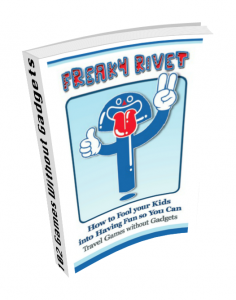 How To Fool Your Kids Into Having Fun So You Can: Travel Games Without Gadgets, by Iyas of Freaky Rivet:
How To Fool Your Kids Into Having Fun So You Can: Travel Games Without Gadgets, by Iyas of Freaky Rivet:Born out of 6 months of travel with the author's own 4 children, How to Fool Your Kids Into Having Fun So You Can is an ebook packed with over 100 games for travelling without gadgets. These are not just your standard car or plane games, but also ones to keep them amused in restaurants, hotel lobbies, boats, and all kinds of places you might find yourself. Some will educate them along the way; most are just outright fun. And it doesn't have to be in some far-flung continent — they are just as useful even at your local deli. You could give your kids an electronic game — but this way you can give them some good old-fashioned fun interacting with people and the environment around them. Bring your sense of humour, and dive in.
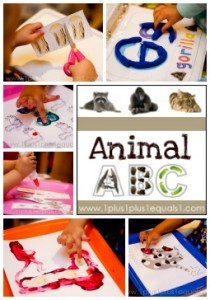 Animal ABCs
, by Carisa of 1+1+1=1:
Animal ABCs
, by Carisa of 1+1+1=1:Animal ABCs is a fun way to take your toddler or preschooler through the alphabet while learning about animals along the way. Each letter features one animal that emphasizes the sound of the letter. Animal ABCs was created for children approximately ages 2-4 years. The bundle includes: Full-size display letters, full-size blank letters and animals to cut for craft, package of printable extras for each letter, all flashcards, all extra additions (Dot Fun, Play Dough Mats, Wall Posters, & Lowercase Letters). Once you purchase, you have access to a private page and you can come back and download anything new that's added!
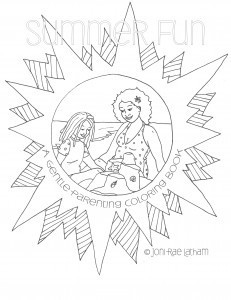 Summer Fun
, by Joni Rae Latham of Tales of a Kitchen Witch:
Summer Fun
, by Joni Rae Latham of Tales of a Kitchen Witch:This is a 15-page coloring book PDF with natural-parenting line drawings by Joni Rae Latham. The drawings depict different families having fun in the summer with scenes including cosleeping, breastfeeding, tandem breastfeeding, and babywearing.
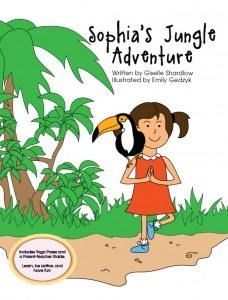 Sophia’s Jungle Adventure
, by Giselle Shardlow of Kids Yoga Stories:
Sophia’s Jungle Adventure
, by Giselle Shardlow of Kids Yoga Stories:Join Sophia's jungle adventure! Fly like a toucan, slither like a snake, and flutter like a butterfly as you act out this journey through a Costa Rican jungle. What else might you see? Follow along with Sophia's story and her yoga moves. The storybook includes a List of Kids Yoga Poses and a Parent-Teacher Guide.
PLUS, three exciting bonuses:
12 play-themed coloring pages, by Hugo Smits:
These coloring pages are a playful example of how Hugo combines his attached parenting style with his passion.
Playful Rituals, by Shawn Ledington Fink:
Sample e-course from the author of The Playful Family
Audio interview with industry expert on treasure baskets, via Melitsa Avila
Inspire your family to grow closer together as you foster your creativity and playfulness!
Get your bundle today for only $14.95, at over 80% off a retail value of $79. It's available only until October 3, so hurry!
***Buying this bundle supports this site! I am very grateful.
BUY NOW!
Published on September 30, 2013 03:00
August 27, 2013
Are You a Homeschooler or Unschooler?

As parents, we think a ton about how our children learn, and what our role is in facilitating and guiding their education. That's why I'm happy to be an affiliate for this new eBundle on Mindful Learning!
The Mindful Learning eBundle holds 6 carefully selected learning resources, with a focus on early reading. This is a practical bundle with over 1,200 pages of learning fun and numerous printables.
If you're stuck in a homeschool rut, if your child keeps asking for fun learning activities and you've no inspiration left, or you just want to refresh your learning approach? This is THE BUNDLE you need for countless hours of learning fun!
Grab your chance to get these six fabulous e-resources at 75% off! That's only $12.50 USD for over $50 worth of learning materials!
***
So what's in this bundle?
Montessori At Home! by John Bowman of Montessori at Home, 520 pages and numerous printables, value $10.95
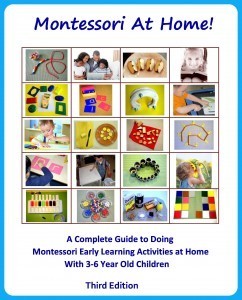
The Third Edition of the Montessori At Home! eBook is the most complete resource available for parents who want to do Montessori activities at home with their 3-6 year old children. This full size, 512-page, $10.95 PDF eBook looks great on all computers, and is optimized for viewing on the iPad. Hundreds of full color photos and links to blogs and videos expand on the information in the eBook, providing a unique resource for parents. Instead of spending months of time during your child’s most formative years researching what to do, you can start doing activities in 1-2 days and have a complete plan at your fingertips for moving on. Over 4000 parents all over the world are using Montessori At Home!
The first chapters contain exactly the information parents need to know to get started quickly and with a firm understanding of Montessori. They include information on Maria Montessori and her observations of children, the neuroscience of early childhood, implementing Montessori principles in parenting, and using learning materials at home. Clear descriptions for over 300 activities and hands-on materials follow in the areas of Practical Life, Sensorial, Art and Music, Digital Life, Science, Language, and Mathematics. Complete sequences for teaching your to child to read and master Montessori math are included. Recommendations are also given for over 225 of the best tablet apps for preschoolers, along with guidelines for safely introducing digital learning to children. 76 pages of free printables are included, as well as the eBook.
You can Read! by Carisa of 1+1+1=1, over 300 pages, value $10
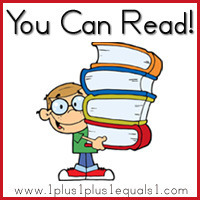 You Can Read is a simple sight word program developed with younger readers in mind. Children learn to read at different ages and some show the reading readiness signs at much younger ages than others. These children are ready to learn words and reading skills, they just aren't ready for complex worksheets and activities often available to children who are a bit older when they are learning. Carisa created this program for children who are showing reading readiness signs at a younger age, approximately ages 3-5. Older children can use these printables and activities also; they were just created with a younger reader in mind!
You Can Read is a simple sight word program developed with younger readers in mind. Children learn to read at different ages and some show the reading readiness signs at much younger ages than others. These children are ready to learn words and reading skills, they just aren't ready for complex worksheets and activities often available to children who are a bit older when they are learning. Carisa created this program for children who are showing reading readiness signs at a younger age, approximately ages 3-5. Older children can use these printables and activities also; they were just created with a younger reader in mind!The printables are based on the Dolch Pre Primer and Primer Sight Word lists, as well as a few I added in, for a total of 72 words. To see the entire word list, and list of activities included in each set, see the You Can Read Information Page
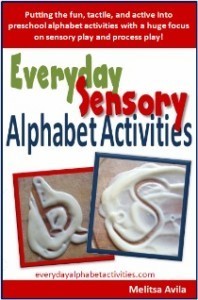 Everyday Sensory Alphabet Activities, by Melitsa Avila of Raising Playful Tots, 99 pages, value $9Everyday Sensory Alphabet Activities is your go to solution for wriggly jiggly children who want to craft and play with alphabet activities that focus on the process along with audio from educators about alphabet learning to set things going in the right direction.
Everyday Sensory Alphabet Activities, by Melitsa Avila of Raising Playful Tots, 99 pages, value $9Everyday Sensory Alphabet Activities is your go to solution for wriggly jiggly children who want to craft and play with alphabet activities that focus on the process along with audio from educators about alphabet learning to set things going in the right direction.Follow raising playful tots on Twitter - Facebook - Pinterest
Book Love: Help Your Child Grow From Reluctant to Enthusiastic Reader, by Melissa Taylor of Imagination Soup, 130 pages, value $9.97
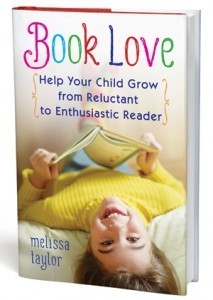 What if you could get your reluctant reader to love books?
What if you could get your reluctant reader to love books?Kids don't like to read for four reasons: too tricky - too blurry - too boring - too sitty.
Discover why your child doesn't like to read … and what to do about it!
Then turn it into Book Love!
In Book Love, you'll find lots of unique, fun, and exciting ideas for your child based on why he or she doesn't like reading. What else will you find in Book Love? - book lists by interests (with links) - alphabet and phonics activities and crafts - sight word games - favorite reading products - rhyming word play games - printables - and more! Do you want your child to love reading?
Then you need this book.
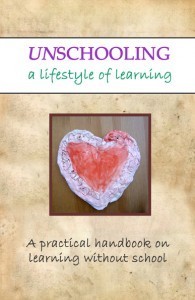 Unschooling: A Lifestyle of Learning, by Sara McGrath, 120 pages, value $4.99A Practical Handbook on Learning Without School: People who feel drawn to the philosophical principles of unschooling often ask 'How do you unschool?' While acknowledging that each family approaches the unschooling lifestyle from a unique standpoint, I offer the details of my family’s experiences, along with specific advice for meeting legal requirements without sacrificing your ideals.
Unschooling: A Lifestyle of Learning, by Sara McGrath, 120 pages, value $4.99A Practical Handbook on Learning Without School: People who feel drawn to the philosophical principles of unschooling often ask 'How do you unschool?' While acknowledging that each family approaches the unschooling lifestyle from a unique standpoint, I offer the details of my family’s experiences, along with specific advice for meeting legal requirements without sacrificing your ideals.More info here.
What Will We Learn Today? Easy Homeschooling Activities, by Lauren Wayne of Hobo Mama, 154 pages, value $5.99
 Are you a homeschooling parent, or do you want to be? Maybe you wonder how learning can fit into everyday life. Or maybe you’re sure it can, but some days you and your child simply run out of ideas of what to do that’s not the same old-same old.
Are you a homeschooling parent, or do you want to be? Maybe you wonder how learning can fit into everyday life. Or maybe you’re sure it can, but some days you and your child simply run out of ideas of what to do that’s not the same old-same old.That’s where this book comes in. It’s an ideabook of more than 550 fun and creative ideas that teach and reinforce learning under eight key curricular subjects. Whether you’re homeschooling, unschooling, or regular schooling, your preschool and school-age kids will enjoy these quick and fun activities that engage their minds and creativity.
The ideas are time- and child-tested activities that our kids enjoy. For them, there’s no division between “learning� and “life� — it’s all of one piece. These idea-joggers use very little in the way of special materials or money but give a lot in terms of natural learning and family connection.
***
This sale lasts for only 4 days, so you'll have to be quick! The sale starts Sunday, August 25, and ends Wednesday, August 28! Buying this bundle is a great way to support this site, since I earn an affiliate commission for each sale through the links on this site. Thank you!
BUY NOW!
Published on August 27, 2013 09:00
August 25, 2013
Mindful Learning eBundle!

As parents, we think a ton about how our children learn, and what our role is in facilitating and guiding their education. That's why I'm happy to be an affiliate for this new eBundle on Mindful Learning!
The Mindful Learning eBundle holds 6 carefully selected learning resources, with a focus on early reading. This is a practical bundle with over 1,200 pages of learning fun and numerous printables.
If you're stuck in a homeschool rut, if your child keeps asking for fun learning activities and you've no inspiration left, or you just want to refresh your learning approach? This is THE BUNDLE you need for countless hours of learning fun!
Grab your chance to get these six fabulous e-resources at 75% off! That's only $12.50 USD for over $50 worth of learning materials!
***
So what's in this bundle?
Montessori At Home! by John Bowman of Montessori at Home, 520 pages and numerous printables, value $10.95

The Third Edition of the Montessori At Home! eBook is the most complete resource available for parents who want to do Montessori activities at home with their 3-6 year old children. This full size, 512-page, $10.95 PDF eBook looks great on all computers, and is optimized for viewing on the iPad. Hundreds of full color photos and links to blogs and videos expand on the information in the eBook, providing a unique resource for parents. Instead of spending months of time during your child’s most formative years researching what to do, you can start doing activities in 1-2 days and have a complete plan at your fingertips for moving on. Over 4000 parents all over the world are using Montessori At Home!
The first chapters contain exactly the information parents need to know to get started quickly and with a firm understanding of Montessori. They include information on Maria Montessori and her observations of children, the neuroscience of early childhood, implementing Montessori principles in parenting, and using learning materials at home. Clear descriptions for over 300 activities and hands-on materials follow in the areas of Practical Life, Sensorial, Art and Music, Digital Life, Science, Language, and Mathematics. Complete sequences for teaching your to child to read and master Montessori math are included. Recommendations are also given for over 225 of the best tablet apps for preschoolers, along with guidelines for safely introducing digital learning to children. 76 pages of free printables are included, as well as the eBook.
You can Read! by Carisa of 1+1+1=1, over 300 pages, value $10
 You Can Read is a simple sight word program developed with younger readers in mind. Children learn to read at different ages and some show the reading readiness signs at much younger ages than others. These children are ready to learn words and reading skills, they just aren't ready for complex worksheets and activities often available to children who are a bit older when they are learning. Carisa created this program for children who are showing reading readiness signs at a younger age, approximately ages 3-5. Older children can use these printables and activities also; they were just created with a younger reader in mind!
You Can Read is a simple sight word program developed with younger readers in mind. Children learn to read at different ages and some show the reading readiness signs at much younger ages than others. These children are ready to learn words and reading skills, they just aren't ready for complex worksheets and activities often available to children who are a bit older when they are learning. Carisa created this program for children who are showing reading readiness signs at a younger age, approximately ages 3-5. Older children can use these printables and activities also; they were just created with a younger reader in mind!The printables are based on the Dolch Pre Primer and Primer Sight Word lists, as well as a few I added in, for a total of 72 words. To see the entire word list, and list of activities included in each set, see the You Can Read Information Page
 Everyday Sensory Alphabet Activities, by Melitsa Avila of Raising Playful Tots, 99 pages, value $9Everyday Sensory Alphabet Activities is your go to solution for wriggly jiggly children who want to craft and play with alphabet activities that focus on the process along with audio from educators about alphabet learning to set things going in the right direction.
Everyday Sensory Alphabet Activities, by Melitsa Avila of Raising Playful Tots, 99 pages, value $9Everyday Sensory Alphabet Activities is your go to solution for wriggly jiggly children who want to craft and play with alphabet activities that focus on the process along with audio from educators about alphabet learning to set things going in the right direction.Follow raising playful tots on Twitter - Facebook - Pinterest
Book Love: Help Your Child Grow From Reluctant to Enthusiastic Reader, by Melissa Taylor of Imagination Soup, 130 pages, value $9.97
 What if you could get your reluctant reader to love books?
What if you could get your reluctant reader to love books?Kids don't like to read for four reasons: too tricky - too blurry - too boring - too sitty.
Discover why your child doesn't like to read … and what to do about it!
Then turn it into Book Love!
In Book Love, you'll find lots of unique, fun, and exciting ideas for your child based on why he or she doesn't like reading. What else will you find in Book Love? - book lists by interests (with links) - alphabet and phonics activities and crafts - sight word games - favorite reading products - rhyming word play games - printables - and more! Do you want your child to love reading?
Then you need this book.
 Unschooling: A Lifestyle of Learning, by Sara McGrath, 120 pages, value $4.99A Practical Handbook on Learning Without School: People who feel drawn to the philosophical principles of unschooling often ask 'How do you unschool?' While acknowledging that each family approaches the unschooling lifestyle from a unique standpoint, I offer the details of my family’s experiences, along with specific advice for meeting legal requirements without sacrificing your ideals.
Unschooling: A Lifestyle of Learning, by Sara McGrath, 120 pages, value $4.99A Practical Handbook on Learning Without School: People who feel drawn to the philosophical principles of unschooling often ask 'How do you unschool?' While acknowledging that each family approaches the unschooling lifestyle from a unique standpoint, I offer the details of my family’s experiences, along with specific advice for meeting legal requirements without sacrificing your ideals.More info here.
What Will We Learn Today? Easy Homeschooling Activities, by Lauren Wayne of Hobo Mama, 154 pages, value $5.99
 Are you a homeschooling parent, or do you want to be? Maybe you wonder how learning can fit into everyday life. Or maybe you’re sure it can, but some days you and your child simply run out of ideas of what to do that’s not the same old-same old.
Are you a homeschooling parent, or do you want to be? Maybe you wonder how learning can fit into everyday life. Or maybe you’re sure it can, but some days you and your child simply run out of ideas of what to do that’s not the same old-same old.That’s where this book comes in. It’s an ideabook of more than 550 fun and creative ideas that teach and reinforce learning under eight key curricular subjects. Whether you’re homeschooling, unschooling, or regular schooling, your preschool and school-age kids will enjoy these quick and fun activities that engage their minds and creativity.
The ideas are time- and child-tested activities that our kids enjoy. For them, there’s no division between “learning� and “life� — it’s all of one piece. These idea-joggers use very little in the way of special materials or money but give a lot in terms of natural learning and family connection.
***
This sale lasts for only 4 days, so you'll have to be quick! The sale starts Sunday, August 25, and ends Wednesday, August 28! Buying this bundle is a great way to support this site, since I earn an affiliate commission for each sale through the links on this site. Thank you!
BUY NOW!
Published on August 25, 2013 08:00
July 27, 2013
Safety Bracelet How-To
I saw this idea awhile back and don't recall where, so I can't give credit to whomever thought it up. I've had the cord and beads for months, waiting for me to look up knot tying on the Internet. It's finally done and my daughter loves her new 'jewelry' and I even took pictures so I could share my hard won knot skills.
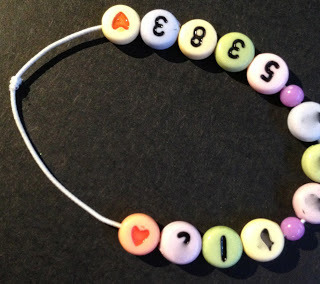
This is the finished product. It's my cell phone number, which is obvious upon inspection, but just looks like any beaded bracelet from a distance. It doesn't give any would-be attackers information to use to convince my daughter to go with them, but it does give someone a way to contact me if needed. I made a bracelet, but you could adapt it to hang from a ribbon you pin to clothing, too. Our local craft stores didn't have beads with numbers when I was looking. I ended up with an alphabet and number mega-assortment from Walmart. Which I have dumped out on my floor at least three times so far. I didn't get around to looking online, so I'm not sure if you can buy just what you need or have to go to the risk of spilling 988 little plastic beads that will take up permanent residence between the wall and some obscenely heavy piece of furniture. (The two separator beads came from a different unwise purchase...)
After you obtain your beads and locate all the numbers of your phone number, string them on an elastic thread (or ribbon) thin enough to fit the smallest bead opening. (I wasn't risking a fourth spill to get more decorative options.) Leave enough length to tie the elastic - I left about six inches extra because the elastic is challenging to work with.
The knot I used is called the Shake Hands Bend and I picked it because the tied ends come back out parallel to the main lines, instead of sticking out perpendicular. It's also symmetric, making it pretty. Although claimed to be easy to untie, after 'fairing' the knot, or pulling it tight, I wasn't able to undo it and it didn't come out even after clipping the tails short and pulling pretty hard on it. You're welcome to use any knot you choose, but if you don't have a favorite (or a clue, like me) this one seems to work pretty well.
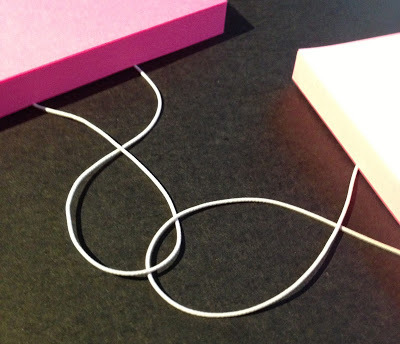
It took me awhile to figure this knot out and the elastic was unruly, so I took to anchoring the ends after getting the over and under and arounds for each step. The bottom lines are the main lines that will have the beads on them and the tie ends you'll eventually cut off pointing up between them.
Coming from the right main line, make a loop down and go over the top of the main line (and under the Post-It notes). From the left main line, go under the right loop and out over the top, looping down. Make the full intertwined loop by taking the left tail end under the left main line.

Squiggle them together. Just kidding. Leave the left loop anchored and work with the right tail end. I'll confess to breaking out tweezers here. Take the right tail end that was pointing up and loop it down, first going under the right main line, then under the left main line, and up where the two loops intersect, over both lines.

This step makes the loops symmetric. Work with the left tie end (the right tie end is at the left side of this picture, not under Post-It notes) which was under the left main line and go over the right and left lines, in through the intersecting loops (where the right tie end came up through) and under the right and left loops.
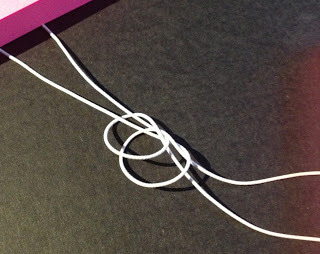
If everything is the right place, when you start tightening the knot you'll see these two loops form. If not, it'll either pop apart or get lopsided. You can undo it and try again (or try another knot) at this point, but probably not after tightening all the way. If you need to adjust the bracelet length, maneuver the loops so the main lines first cross where you want the knot and pull the tail ends to tighten. Pulling equally on all four lines may make the bracelet too loose.
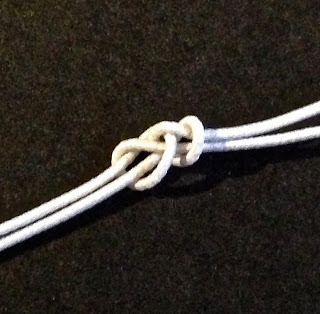
Your knot should look like this just before being secured. It does look pretty, for a knot, no? After tightening, clip off the tail ends. I snipped flush with the knot, but because the ends won't poke, you can leave them longer, if you want.
You can have your child wear this all the time, just in case, or only for outings like field trips, or anywhere in between. Since it's (relatively) easy to make, you can redo it out for new colors, a changed number, or a bigger size whenever you want.

This is the finished product. It's my cell phone number, which is obvious upon inspection, but just looks like any beaded bracelet from a distance. It doesn't give any would-be attackers information to use to convince my daughter to go with them, but it does give someone a way to contact me if needed. I made a bracelet, but you could adapt it to hang from a ribbon you pin to clothing, too. Our local craft stores didn't have beads with numbers when I was looking. I ended up with an alphabet and number mega-assortment from Walmart. Which I have dumped out on my floor at least three times so far. I didn't get around to looking online, so I'm not sure if you can buy just what you need or have to go to the risk of spilling 988 little plastic beads that will take up permanent residence between the wall and some obscenely heavy piece of furniture. (The two separator beads came from a different unwise purchase...)
After you obtain your beads and locate all the numbers of your phone number, string them on an elastic thread (or ribbon) thin enough to fit the smallest bead opening. (I wasn't risking a fourth spill to get more decorative options.) Leave enough length to tie the elastic - I left about six inches extra because the elastic is challenging to work with.
The knot I used is called the Shake Hands Bend and I picked it because the tied ends come back out parallel to the main lines, instead of sticking out perpendicular. It's also symmetric, making it pretty. Although claimed to be easy to untie, after 'fairing' the knot, or pulling it tight, I wasn't able to undo it and it didn't come out even after clipping the tails short and pulling pretty hard on it. You're welcome to use any knot you choose, but if you don't have a favorite (or a clue, like me) this one seems to work pretty well.

It took me awhile to figure this knot out and the elastic was unruly, so I took to anchoring the ends after getting the over and under and arounds for each step. The bottom lines are the main lines that will have the beads on them and the tie ends you'll eventually cut off pointing up between them.
Coming from the right main line, make a loop down and go over the top of the main line (and under the Post-It notes). From the left main line, go under the right loop and out over the top, looping down. Make the full intertwined loop by taking the left tail end under the left main line.

Squiggle them together. Just kidding. Leave the left loop anchored and work with the right tail end. I'll confess to breaking out tweezers here. Take the right tail end that was pointing up and loop it down, first going under the right main line, then under the left main line, and up where the two loops intersect, over both lines.

This step makes the loops symmetric. Work with the left tie end (the right tie end is at the left side of this picture, not under Post-It notes) which was under the left main line and go over the right and left lines, in through the intersecting loops (where the right tie end came up through) and under the right and left loops.

If everything is the right place, when you start tightening the knot you'll see these two loops form. If not, it'll either pop apart or get lopsided. You can undo it and try again (or try another knot) at this point, but probably not after tightening all the way. If you need to adjust the bracelet length, maneuver the loops so the main lines first cross where you want the knot and pull the tail ends to tighten. Pulling equally on all four lines may make the bracelet too loose.

Your knot should look like this just before being secured. It does look pretty, for a knot, no? After tightening, clip off the tail ends. I snipped flush with the knot, but because the ends won't poke, you can leave them longer, if you want.
You can have your child wear this all the time, just in case, or only for outings like field trips, or anywhere in between. Since it's (relatively) easy to make, you can redo it out for new colors, a changed number, or a bigger size whenever you want.
Published on July 27, 2013 09:49
July 22, 2013
Another Chance to Win The Newbie's Guide to Positive Parenting
Have you read Positive Parenting in Action? 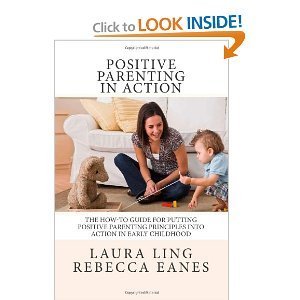
If you've purchased Positive Parenting in Action, you have a chance to win The Newbie's Guide to Positive Parenting! Here's how to enter:
1. Go to Amazon and leave a review for Positive Parenting in Action. 2. Comment below that you have left a review. Leave your email so I can contact if you if you win!
That's it! Once I confirm your review has been left on Amazon, you will be entered to win a free copy of The Newbie's Guide to Positive Parenting. A winner will be chosen on July 31, 2013 by Random Picker.

If you've purchased Positive Parenting in Action, you have a chance to win The Newbie's Guide to Positive Parenting! Here's how to enter:
1. Go to Amazon and leave a review for Positive Parenting in Action. 2. Comment below that you have left a review. Leave your email so I can contact if you if you win!
That's it! Once I confirm your review has been left on Amazon, you will be entered to win a free copy of The Newbie's Guide to Positive Parenting. A winner will be chosen on July 31, 2013 by Random Picker.
Do you want to create a more positive and peaceful home? Are you tired of parenting formulas and techniques that just don't work and leave you feeling at odds with your child? Learn the 5 principles of positive parenting and discover how to bring connection and peace back into your relationship with your child. You'll learn a new way in which to relate to your child, one which fosters connection rather than disconnection, respect rather than rebellion, and cultivates a healthy relationship which you can enjoy throughout the years.
Published on July 22, 2013 09:13
July 15, 2013
The Gentle Leader
It's the same debate. Over and over and over again. Whenever we are discussing gentle, respectful parenting, those who misunderstand our philosophy always say the same things.
"Kids need rules!""You can't let them run the house!""You have to discipline kids!"
Why is it automatically assumed that if we are not tyrannical, we are not in authority?
Why does the position of authority have to come with arrogance? With punishment? With belligerence? With a heavy hand?
There is no question that children need guidance, leadership, rules, and direction, but I do question the effectiveness and the consequences of the iron fist.
This doesn't mean relinquishing our parental authority but rather redefining it. We can be kind without yielding. We can be strong without harshness. We can be confident without arrogance. It's not an either/or deal; either you rule with an iron fist or you're permissive. There is a whole gray area that is just and fair, respectful and civil, gentle and soft-spoken while at the same time being firm, having high expectations and setting clear rules. In the gray area is where positive parenting lies.
We are gentle leaders, but we are leaders nonetheless.
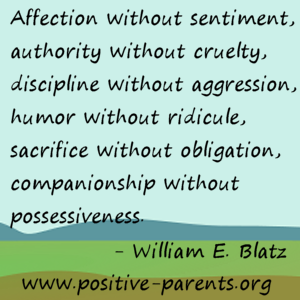
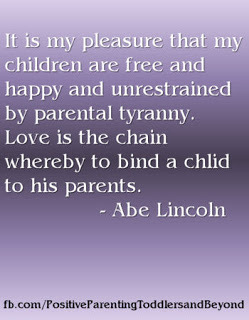
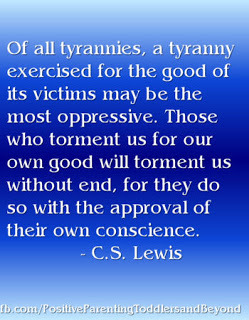
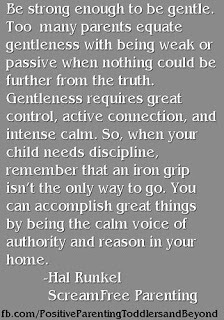
"Kids need rules!""You can't let them run the house!""You have to discipline kids!"
Why is it automatically assumed that if we are not tyrannical, we are not in authority?
Why does the position of authority have to come with arrogance? With punishment? With belligerence? With a heavy hand?
There is no question that children need guidance, leadership, rules, and direction, but I do question the effectiveness and the consequences of the iron fist.
This doesn't mean relinquishing our parental authority but rather redefining it. We can be kind without yielding. We can be strong without harshness. We can be confident without arrogance. It's not an either/or deal; either you rule with an iron fist or you're permissive. There is a whole gray area that is just and fair, respectful and civil, gentle and soft-spoken while at the same time being firm, having high expectations and setting clear rules. In the gray area is where positive parenting lies.
We are gentle leaders, but we are leaders nonetheless.




Published on July 15, 2013 09:03
July 11, 2013
The Newbie's Guide to Positive Parenting Book Giveaway!
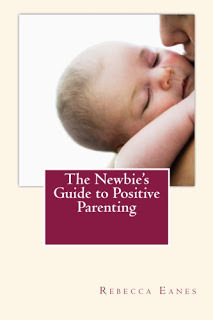
We're giving away one paperback copy of The Newbie's Guide to Positive Parenting! This Amazon best-seller is an introduction to the philosophy and principles of Positive Parenting.
Do you want to create a more positive and peaceful home? Are you tired of parenting formulas and techniques that just don't work and leave you feeling at odds with your child?
Learn the 5 principles of positive parenting and discover how to bring connection and peace back into your relationship with your child. You'll learn a new way in which to relate to your child, one which fosters connection rather than disconnection, respect rather than rebellion, and cultivates a healthy relationship which you can enjoy throughout the years. TABLE OF CONTENTS
Introduction
Chapter 1: What is Positive Parenting
Chapter 2: This is Not Permissive Parenting
Chapter 3: Changing Your Mindset
Chapter 4: Peace Starts With You
Chaper 5: Leader of the Pack
Chapter 6: Building a Positive Self-Concept
Chapter 7: The Power of the Tongue
Chapter 8: Teaching Tools
Chapter 9: Consequences and Problem-Solving
Chapter 10: Enforcing Limits Versus Punishment
Chapter 11: Ten Alternatives to Punishments
Chapter 12: Ten Things That Are More Important Than Discipline
Chapter 13: Bring It Home
Chapter 14: Change the World
Giveaway ends on July 25, 2013
*If the giveaway won't load, leave a comment below to enter. Include your email address so I can't contact you if you win*
Published on July 11, 2013 10:46
July 9, 2013
Tips for Fostering Sibling Connection
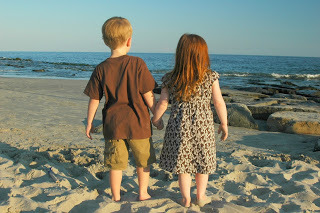
My firstborn was barely 2 when his baby brother was born. He was in awe those first few days, but his admiration quickly wore off. Once he realized this new person was sticking around, taking up a lot of mommy's time, he became rather upset. He ignored his brother's very existence for the following 8 or so months.
Now, they really are the best of friends. Over the years, I have found some things to be helpful in fostering their connection, and others to be detrimental to it.
Here are some mistakes I have made that fostered rivalry rather than connection:
Comparison
Though I have tried to make a point not to compare my children to each other, during a time of frustrating potty training, I did utter the words "Your brother was potty trained by 2! Why are you making this so difficult?"
As you can guess, this was not helpful in either getting him potty trained or in cultivating fuzzy feelings for his brother. All it proved to do was make him feel "less than." Comparisons are relationship killers and self-esteem blows.
Behavior Charts
In the very early stages of my transition to positive parenting, when I was still aiming for a nicer way to control them, I used a behavior chart. Each one had his own chart, and what I did was this: There were 3 pegs on each chart, and from them hung squares that had smiley faces on one side and sad faces on the other. When one misbehaved, I turned over one sad face. Three sad faces resulted in a consequence, usually a time out. It seemed like a good idea at the time. In fact, this very chart would probably be a viral hit on Pinterest, but it was a disaster in our house on several levels. For the sake of consistency, I'll only discuss what it did to the sibling relationship.
"You have 2 sad faces already! Ha!"
"Ooooh, you're going to time out if you get one more sad face!"
"You have 1 sad face and I don't have any!"
Yes, you can see how this induced rivalry and competition. Not good for their relationship, even worse for their behavior. This chart was an epic fail.
Separate Chore Charts
More recently, both of my boys had separate responsibility charts. Several chores or responsibilities were listed on each chart and they checked off a box when they completed the job. Again, this didn't make either child more responsible, but it did create more competition.
"Who has more check marks?"
"I have more than you! I win!"
Now here are some things that have made a positive difference in their relationship:
Acknowledge the Bond
When I stopped getting in the way by creating rivalry, their relationship naturally improved. I made a point to notice and point out when they were kind to each other or playing well together. There is something to be said for speaking out what you want to have happen in your life. I've read that in many articles about positivity, and it turns out that it works amazingly well. What you focus on, you get more of. When I focused on their rivalry, I got more of it. When I focused on their connection, things improved greatly.
Don't Tolerate Disrespect Between Siblings
I will not allow name calling, physical aggression, or other such bullying or disrespect between them. If they argue, and they do, I give them a chance to work it out peacefully themselves (because by now we've run through problem-solving MANY times and they know how to do it) and most times they say "we can solve this, mom." However, if emotions are charged and peace isn't being reached, I step in and mediate or separate them.
How do I enforce my "no disrespect" limit without punishment? I knew you were going to ask. ;)
Punishments are, simply put, something imposed on a child to make him "pay" for his wrongdoing that are generally not related to the 'offense.' Since teaching and connection are my priorities, it's quite easy to avoid punishments in favor of teaching. However, teaching sometimes means they don't like the consequence of their choice or are momentarily upset with my decision when I have to step in. Not punishing doesn't mean it's a free for all around here. I expect them to follow family rules.
If my son is physically aggressive (hits, pushes, scratches, etc) then I take him to time in. By this point, we've problem-solved and discussed alternatives so much it's not really necessary to keep doing that. He gets it. He knows what he's supposed to do and what he could have done better, but he's 4 and he doesn't always have control. I'm aware of his immature executive function. In the time in, he sits with me and I ask him how he's going to repair the rift. He always chooses make a drawing of them holding hands. He does so and takes it to his brother. They smile and hug, the rift repaired.
If they fight over the Kindle and can't come to a peaceful agreement, I take the Kindle. "Your relationship is more important than the Kindle and I won't have you fighting over it. When you come to an agreement, let me know."
We don't have issues with name calling or teasing, but I would treat that like I treat aggression. Time in, problem-solve, repair.
Create a Team Atmosphere
We're a team, and we tackle things as a team. The individual chore charts have been replaced by a team chart. They tackle jobs together, and then get a check mark for completing it together. I also create a team atmosphere through such things as family meetings where we all get equal chance to weigh in on things like vacations, weekend plans, issues, etc. We frequently talk about the importance of family. Our weekends consist of the four of us spending quality time together, laughing, playing, and having fun. Family traditions, weekend routines, and routine special occasions all foster the team/family atmosphere and loving bond between us all.
Individual Attention
When each individual child feels wholly loved and connected to his parents and an important member of the family unit, he is much less likely to bicker and fight for attention. Give each child individual time, fill his cup, take interest in what he's interested in, and maintain a strong connection with each one individually.
Sometimes being a brother is even better than being a superhero. - Marc Brown
A sister is a gift to the heart, a friend to the spirit, a golden thread to the meaning of life. - Isadora James
Published on July 09, 2013 10:32



